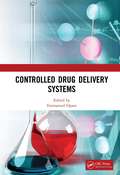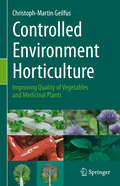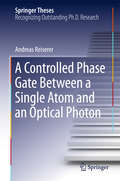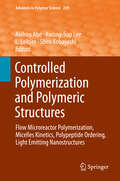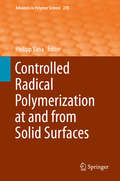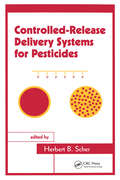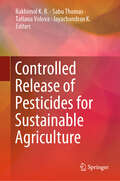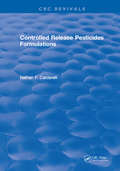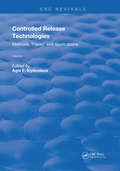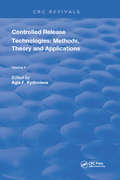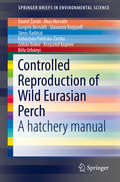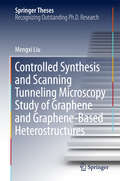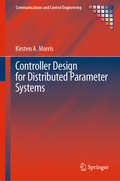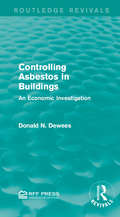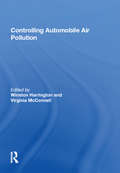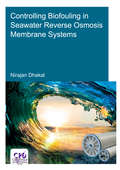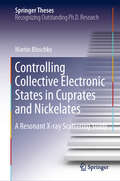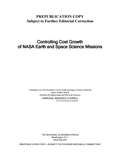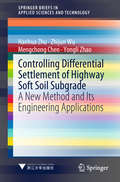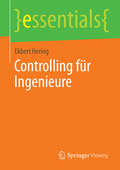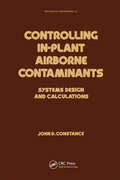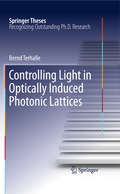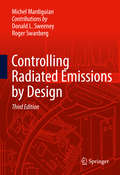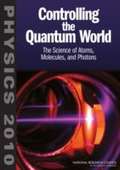- Table View
- List View
Controlled Drug Delivery Systems
by Emmanuel OparaThis book will describe current research on drug delivery systems that encompass four broad categories, namely: routes of delivery, delivery vehicles, payload, and targeting strategies. Where appropriate delivery vehicles and relevant release of specific agents in any of these categories in clinical application will be discussed. All chapters will highlight the translational aspects of the various technologies discussed and will provide insights into the advantages of such delivery systems over current ones in clinical or research use. Each technology reviewed in this book will have significant potential to improve patients' lives by enhancing the therapeutic efficacy of drugs. This book: Discusses the various factors that mitigate effective oral insulin delivery and the current status of research efforts to overcome these barriers along with recent clinical projections Examines the advantages and disadvantages of each drug delivery system Examines the standard method of accomplishing controlled drug release through the incorporation of the drugs within polymeric biomaterials such as capsules and microcapsules as well as other vehicles such as liposomes Discusses various controlled drug delivery systems, including sustained release delivery systems and pulse or delayed release, e.g. to target different regions of the gastrointestinal tract. In view of these wide-ranging technological areas, and the up-to-date discussions of opportunities and challenges associated with these applications, the book should provide readers from technology, materials science, pharmacology and clinical disciplines with very valuable information.
Controlled Environment Horticulture: Improving Quality of Vegetables and Medicinal Plants
by Christoph-Martin GeilfusAn understanding of crop physiology and ecophysiology enables the horticulturist to manipulate a plant’s metabolism towards the production of compounds that are beneficial for human health when that plant is part of the diet or the source of phytopharmaceutical compounds. The first part of the book introduces the concept of Controlled Environment Horticulture as a horticultural production technique used to maximize yields via the optimization of access to growing factors. The second part describes the use of this production technique in order to induce stress responses in the plant via the modulation of these growing factors and, importantly, the way that this manipulation induces defence reactions in the plant resulting in the production of compounds beneficial for human health. The third part provides guidance for the implementation of this knowledge in horticultural production.
A Controlled Phase Gate Between a Single Atom and an Optical Photon (Springer Theses)
by Andreas ReisererThis thesis reports on major steps towards the realization of scalable quantum networks. It addresses the experimental implementation of a deterministic interaction mechanism between flying optical photons and a single trapped atom. In particular, it demonstrates the nondestructive detection of an optical photon. To this end, single rubidium atoms are trapped in a three-dimensional optical lattice at the center of an optical cavity in the strong coupling regime. Full control over the atomic state -- its position, its motion, and its electronic state -- is achieved with laser beams applied along the resonator and from the side. When faint laser pulses are reflected from the resonator, the combined atom-photon state acquires a state-dependent phase shift. In a first series of experiments, this is employed to nondestructively detect optical photons by measuring the atomic state after the reflection process. Then, quantum bits are encoded in the polarization of the laser pulse and in the Zeeman state of the atom. The state-dependent phase shift mediates a deterministic universal quantum gate between the atom and one or two successively reflected photons, which is used to generate entangled atom-photon, atom-photon-photon, and photon-photon states out of separable input states.
Controlled Polymerization and Polymeric Structures: Flow Microreactor Polymerization, Micelles Kinetics, Polypeptide Ordering, Light Emitting Nanostructures (Advances in Polymer Science #259)
by Akihiro Abe Kwang-Sup Lee L. Leibler Shiro KobayashiAdvances in Polymer Science enjoys a longstanding tradition and good reputation in its community. Each volume is dedicated to a current topic, and each review critically surveys one aspect of that topic, to place it within the context of the volume. The volumes typically summarize the significant developments of the last 5 to 10 years and discuss them critically, presenting selected examples, explaining and illustrating the important principles, and bringing together many important references of primary literature. On that basis, future research directions in the area can be discussed. Advances in Polymer Science volumes thus are important references for every polymer scientist, as well as for other scientists interested in polymer science - as an introduction to a neighboring field, or as a compilation of detailed information for the specialist.
Controlled Radical Polymerization at and from Solid Surfaces (Advances in Polymer Science #270)
by Philipp VanaThe series Advances in Polymer Science presents critical reviews of the present and future trends in polymer and biopolymer science. It covers all areas of research in polymer and biopolymer science including chemistry, physical chemistry, physics, material science. The thematic volumes are addressed to scientists, whether at universities or in industry, who wish to keep abreast of the important advances in the covered topics. Advances in Polymer Science enjoys a longstanding tradition and good reputation in its community. Each volume is dedicated to a current topic, and each review critically surveys one aspect of that topic, to place it within the context of the volume. The volumes typically summarize the significant developments of the last 5 to 10 years and discuss them critically, presenting selected examples, explaining and illustrating the important principles, and bringing together many important references of primary literature. On that basis, future research directions in the area can be discussed. Advances in Polymer Science volumes thus are important references for every polymer scientist, as well as for other scientists interested in polymer science - as an introduction to a neighboring field, or as a compilation of detailed information for the specialist. Review articles for the individual volumes are invited by the volume editors. Single contributions can be specially commissioned. Readership: Polymer scientists, or scientists in related fields interested in polymer and biopolymer science, at universities or in industry, graduate students
Controlled-Release Delivery Systems for Pesticides
by Herbert B. ScherHighlighting means of reducing toxicity, increasing efficacy, lessening environmental impact, and facilitating product development, this work covers up-to-date advances in pesticide delivery technologies. It evaluates pesticide formulations and their use in mixtures that reduce physical incompatibilities in spray tanks and biological anatagonism in the field.
Controlled Release of Pesticides for Sustainable Agriculture
by Rakhimol K. R. Sabu Thomas Tatiana Volova Jayachandran K.This book presents an introduction to the concept and need of sustainable agriculture, the mechanisms of conventional and controlled release of pesticides, herbicides and plant hormones. It also contains the carriers which supply controlled release including polymers and nanoparticles. A full chapter is devoted to the theory and simulation aspects.
Controlled Release Pesticides Formulations
by Nathan F. CardarelliThe main goal of this book is to present a summary of the state of the art historical background. Conventional chemical pest control methods are mentioned only as a means of comparison to controlled release. Research endeavour with biological weapons, potential usage of such controls, and the few instances of success are likewise brought into focus with the same motive. Formulations and methods or preparing controlled release pesticides are discussed in some detail as concerns the antifouling and molluscicide areas, where the compounding methodology has been well developed. The mathematical basis of controlled release has been developed to an extent and is presented in an abbreviated form.
Controlled Release Technologies: Methods, Theory, and Applications (Routledge Revivals #1)
by Agis F. KydonieusFirst Published in 1985, this book offers comprehensive insight into the process of administering chemical ingredients. Carefully compiled and filled with a vast repertoire of notes, diagrams, and references this book serves as a useful reference for students of pharmacology and other practitioners in their respective fields.
Controlled Release Technologies: Methods, Theory, and Applications (Routledge Revivals #2)
by Agis F. KydonieusFirst Published in 1985, this book offers comprehensive insight into the process of administering chemical ingredients. Carefully compiled and filled with a vast repertoire of notes, diagrams, and references this book serves as a useful reference for students of pharmacology and other practitioners in their respective fields.
Controlled Reproduction of Wild Eurasian Perch: A hatchery manual (SpringerBriefs in Environmental Science)
by Daniel Żarski Ákos Horváth Gergely Bernáth Sławomir Krejszeff János Radóczi Katarzyna Palińska-Żarska Zoltán Bokor Krzysztof Kupren Béla UrbányiThe work summarizes the current knowledge regarding the controlled reproduction of an emerging aquaculture species, the Eurasian perch (Perca fluviatilis). In great detail it describes and explains the principal of most of the controlled reproductive protocol leading to obtain high quality larvae. The book is primarily intended to be used as a hatchery manual by practicing aquaculturists and laboratory technicians working with this species. On the other hand, it also summarizes the scientific background of the methods applied, therefore, it can serve as a reference for the state-of-the-art in the controlled reproduction of Eurasian perch and other freshwater percid species.
Controlled Synthesis and Scanning Tunneling Microscopy Study of Graphene and Graphene-Based Heterostructures (Springer Theses)
by Mengxi LiuThis thesis focuses on the energy band engineering of graphene. It presents pioneering findings on the controlled growth of graphene and graphene-based heterostructures, as well as scanning tunneling microscopy/scanning tunneling spectroscopy (STM/STS) studies on their electronic structures. The thesis primarily investigates two classes of graphene-based systems: (i) twisted bilayer graphene, which was synthesized on Rh substrates and manifests van Hove singularities near Fermi Level, and (ii) in-plane h-BN-G heterostructures, which were controllably synthesized in an ultrahigh vacuum chamber and demonstrate intriguing electronic properties on the interface. In short, the thesis offers revealing insights into the energy band engineering of graphene-based nanomaterials, which will greatly facilitate future graphene applications.
Controller Design for Distributed Parameter Systems (Communications and Control Engineering)
by Kirsten A. MorrisThis book addresses controller and estimator design for systems that vary both spatially and in time: systems like fluid flow, acoustic noise and flexible structures. It includes coverage of the selection and placement of actuators and sensors for such distributed-parameter systems. The models for distributed parameter systems are coupled ordinary/partial differential equations. Approximations to the governing equations, often of very high order, are required and this complicates both controller design and optimization of the hardware locations. Control system and estimator performance depends not only on the controller/estimator design but also on the location of the hardware. In helping the reader choose the best location for actuators and sensors, the analysis provided in this book is crucial because neither intuition nor trial-and-error is foolproof, especially where multiple sensors and actuators are required, and moving hardware can be difficult and costly. The mechatronic approach advocated, in which controller design is integrated with actuator location, can lead to better performance without increased cost. Similarly, better estimation can be obtained with carefully placed sensors. The text shows how proper hardware placement varies depending on whether, disturbances are present, whether the response should be reduced to an initial condition or whether controllability and/or observability have to be optimized. This book is aimed at non-specialists interested in learning controller design for distributed-parameter systems and the material presented has been used for student teaching. The relevant basic systems theory is presented and followed by a description of controller synthesis using lumped approximations. Numerical algorithms useful for efficient implementation in real engineering systems and practical computational challenges are also described and discussed.
Controlling Asbestos in Buildings: An Economic Investigation (Routledge Revivals)
by Donald N. DeweesAsbestos dust is well-known for causing cancer and other life-threatening illnesses yet still contaminates countless schools, factories and office buildings. This raises the issue of the best way to deal with Asbestos; immediate removal, containment or removal at renovation or demolition. Originally published in 1986, this report aims to evaluate these methods of dealing with asbestos in relation to their cost-effectiveness to conclude the most appropriate solution. This title will be of interest to students of Environmental Studies and Economics.
Controlling Automobile Air Pollution (The\international Library Of Environmental Economics And Policy Ser.)
by Virginia McConnellThis volume includes many of the most influential and interesting academic articles related to the economics of mobile source pollution control. The papers included explore why vehicles and vehicle markets are unique, provide estimates of the type and magnitude of the social costs of driving and examine estimation methods and estimates of the various elasticities of vehicle demand. Analysis of the social costs and policies to reduce both traditional air pollutants and greenhouse gas emissions are included. Selected articles review the range of evaluation of both regulatory and market-based approaches to controlling emissions. The complexity of the effects of different policies are emphasized and the unintended consequences of regulation are explored in the context of vehicle emissions reduction policies.
Controlling Biofouling in Seawater Reverse Osmosis Membrane Systems (IHE Delft PhD Thesis Series)
by Nirajan DhakalSeawater desalination is a rapidly growing coastal industry that is increasingly threatened by algal blooms. Depending on the severity of algal blooms, desalination systems may be forced to shut down because of clogging and/or poor feed water quality. To maintain stable operation and provide good feed water quality to seawater reverse osmosis (SWRO) systems, ultrafiltration (UF) pre-treatment is proposed.This research focused on assessing the ability of UF and other pre-treatment technologies to reduce biofouling in SWRO systems. An improved method to measure bacterial regrowth potential (BRP) was developed and applied at laboratory, pilot and full scale to assess the ability of conventional UF (150 kDa) and tight UF (10 kDa) alone and in combination with a phosphate adsorbent to reduce regrowth potential and delay the onset of biofouling in SWRO.The improved bacterial regrowth potential method employs a natural consortium of marine bacteria as inoculum and flow cytometry. The limit of detection of the BRP method was lowered to 43,000 ± 12,000 cells/mL, which is equivalent to 9.3 ± 2.6 µg-Cglucose/L.The reduction in bacterial regrowth potential after tight UF (10 kDa) was 3 to 4 times higher than with conventional UF (150 kDa). It was further reduced after the application of a phosphate adsorbent, independent of pore size of the UF membrane. Pilot studies demonstrated that the application of tight UF (10 kDa) coupled with a phosphate adsorbent consistently lowered the bacterial regrowth potential and no feed channel pressure drop increase was observed in membrane fouling simulators (MFS) over a period of 21 days. The study also showed that non-backwashable fouling of UF membranes varied strongly with the type of algal species and the algal organic matter (AOM) they release. The presence of polysaccharide (stretching -OH) and sugar ester groups (stretching S=O) was the main cause of non-backwashable fouling.In conclusion, this study showed that an improved BRP method is suitable for the assessment of SWRO pre-treatment systems and it can be a useful tool to develop potential strategies to mitigate biofouling and improve the sustainability of SWRO systems.
Controlling Collective Electronic States in Cuprates and Nickelates: A Resonant X-ray Scattering Study (Springer Theses)
by Martin BluschkeIn this thesis chemical and epitaxial degrees of freedom are used to manipulate charge and spin ordering phenomena in two families of transition metal oxides, while taking advantage of state-of-the-art resonant x-ray scattering (RXS) methods to characterize their microscopic origin in a comprehensive manner. First, the relationship of charge density wave order to both magnetism and the "pseudogap" phenomenon is systematically examined as a function of charge-carrier doping and isovalent chemical substitution in single crystals of a copper oxide high-temperature superconductor. Then, in copper oxide thin films, an unusual three-dimensionally long-range-ordered charge density wave state is discovered, which persists to much higher temperatures than charge-ordered states in other high-temperature superconductors. By combining crystallographic and spectroscopic measurements, the origin of this phenomenon is traced to the epitaxial relationship with the underlying substrate. This discovery opens new perspectives for the investigation of charge order and its influence on the electronic properties of the cuprates. In a separate set of RXS experiments on superlattices with alternating nickel and dysprosium oxides, several temperature- and magnetic-field-induced magnetic phase transitions are discovered. These observations are explained in a model based on transfer of magnetic order and magneto-crystalline anisotropy between the Ni and Dy subsystems, thus establishing a novel model system for the interplay between transition-metal and rare-earth magnetism.
Controlling Cost Growth of NASA Earth and Space Science Missions
by National Research Council of the National AcademiesCost and schedule growth is a problem experienced by many types of projects in many fields of endeavor. Based on prior studies of cost growth in NASA and Department of Defense projects,this book identifies specific causes of cost growth associated with NASA Earth and space science missions and provides guidance on how NASA can overcome these specific problems. The recommendations in this book focus on changes in NASA policies that would directly reduce or eliminate the cost growth of Earth and space science missions. Large cost growth is a concern for Earth and space science missions,and it can be a concern for other missions as well. If the cost growth is large enough,it can create liquidity problems for NASA's Science Mission Directorate that in turn cause cost profile changes and development delays that amplify the overall cost growth for other concurrent and/or pending missions. Addressing cost growth through the allocation of artificially high reserves is an inefficient use of resources because it unnecessarily diminishes the portfolio of planned flights. The most efficient use of resources is to establish realistic budgets and reserves and effective management processes that maximize the likelihood that mission costs will not exceed reserves. NASA is already taking action to reduce cost growth; additional steps,as recommended herein,will help improve NASA's mission planning process and achieve the goal of ensuring frequent mission opportunities for NASA Earth and space science.
Controlling Differential Settlement of Highway Soft Soil Subgrade: A New Method And Its Engineering Applications (SpringerBriefs in Applied Sciences and Technology)
by Yongli Zhao Mengchong Chen Zhijun Wu Hanhua ZhuDrawing on years of practical on-site experience, this book presents a new method for controlling "bridge-head bumping" in soft soil ground. Based on deformation compatibility and control theory of structure, it proposes strategies for improving the design method of soft soil ground and the effective "bridge-head bumping" control method. Soft soil ground is chiefly characterized by a large void ratio, high compressibility, high water content, low impermeability, low strength, strong structure and high sensitivity. As a result, it has pronounced rheological properties, and controlling "bridge-head bumping" in soft soil ground is essential to control the amount of soil rheology-induced unstable successive settlement. The book offers extensive information on this and related topics, making it a valuable guide for engineers in Civil Engineering and Geotechnical Engineering alike.
Controlling für Ingenieure (essentials)
by Ekbert HeringControlling stellt ein ziel-, nutzen- und engpassorientiertes Führungskonzept dar, mit dem Unternehmen kurz-, mittel- und langfristig erfolgreich geführt werden können. Die Ziele werden in Planungen festgehalten, die messbare Soll-Werte enthalten. Werden die tatsächlichen Ist-Werte gemessen, so kann man die Abweichungen von den Planwerten feststellen. Diese Abweichungen lösen eine Steuerung durch Anpassungsmaßnahmen zur Zielerreichung oder Korrektur der Zielgrößen aus. Es wird zwischen strategischem und operativem Controlling unterschieden. Das strategische Controlling dient zur Existenzsicherung, indem es die langfristigen Ziele anhand der Erkenntnisse über zukünftige Marktchancen und -risiken unter Berücksichtigung der eigenen Möglichkeiten und Stärken festlegt. Aufgabe des operativen Controllings ist die Sicherung der Lebensfähigkeit des Unternehmens (Liquidität), einer angemessenen Verzinsung des eingesetzten Kapitals (Rentabilität) sowie ein optimales Kosten- und Leistungsverhältnis (Wirtschaftlichkeit). Strategisches und operatives Controlling werden für alle Funktionen des Unternehmens erläutert.
Controlling In-Plant Airborne Contaminants: Systems Design and Calculations
by John D. ConstanceThis book is a useful reference work for practicing engineers in their evaluation and design of systems for the control of the industrial in-plant environment. It provides design criteria, useful calculations and proven techniques to control the environment in oil refineries and chemical industries.
Controlling Light in Optically Induced Photonic Lattices (Springer Theses)
by Bernd TerhalleDiscrete periodic structures play an important role in physics, and have opened up an exciting new area of investigation in recent years. Questions relating to the control of light in such structures still represent a major challenge. It is this highly active field that is addressed in the present thesis. Using the model system of a photorefractive nonlinearity that allows one to simultaneously create and control photonic lattices by light, the author obtains a comprehensive picture of the control of nonlinear and quantum optics phenomena in photonic lattices. He describes and demonstrates experimentally for the first time resonant transitions in two-dimensional hexagonal lattices, including Rabi oscillations and Landau-Zener tunneling, as well as the direct control and exploitation of these transitions. A particular highlight of this thesis is the study of soliton-cluster switching and control of Zener tunneling.
Controlling Radiated Emissions by Design (The\springer International Series In Engineering And Computer Science Ser. #580)
by Michel MardiguianThe 3rd edition of Controlling Radiated Emissions by Design has been updated to reflect the latest changes in the field. New to this edition is material on aspects of technical advance, specifically long term energy efficiency, energy saving, RF pollution control, etc. This book retains the step-by-step approach for incorporating EMC into every new design, from the ground up. It describes the selection of quieter IC technologies, their implementation into a noise-free printed circuit layout, and the gathering of all these into low radiation packaging, including I/O filtering, connectors and cables considerations. All guidelines are supported by thorough and comprehensive calculated examples. Design engineers, EMC specialists and technicians will benefit from learning about the development of more efficient and economical control of emissions.
Controlling the Quantum World: The Science of Atoms, Molecules, and Photons
by National Research Council of the National AcademiesAs part of the Physics 2010 decadal survey project, the Department of Energy and the National Science Foundation requested that the National Research Council assess the opportunities, over roughly the next decade, in atomic, molecular, and optical (AMO) science and technology. In particular, the National Research Council was asked to cover the state of AMO science, emphasizing recent accomplishments and identifying new and compelling scientific questions. Controlling the Quantum World, discusses both the roles and challenges for AMO science in instrumentation; scientific research near absolute zero; development of extremely intense x-ray and laser sources; exploration and control of molecular processes; photonics at the nanoscale level; and development of quantum information technology. This book also offers an assessment of and recommendations about critical issues concerning maintaining U.S. leadership in AMO science and technology.
Controlling the Quantum World of Atoms, Molecules, and Photons: An Interim Report
by National Research Council of the National AcademiesAs part of its Physics 2010 decadal survey, the NRC has undertaken a study of opportunities in atomic, molecular, and optical (AMO) science and technology over roughly the next decade. This study has been requested by the Department of Energy and the National Science Foundation. They asked the NRC to assess the state of AMO science, emphasizing recent accomplishments and identifying new and compelling scientific questions. A final report on this study is expected in the summer 2006. This interim report provides a preview of the final document. It presents a summary of the key opportunities in forefront AMO science and in closely related technologies, and a discussion of some of the broad-scale conclusions of the final report. The interim report also describes how AMO science supports national R&D priorities.
